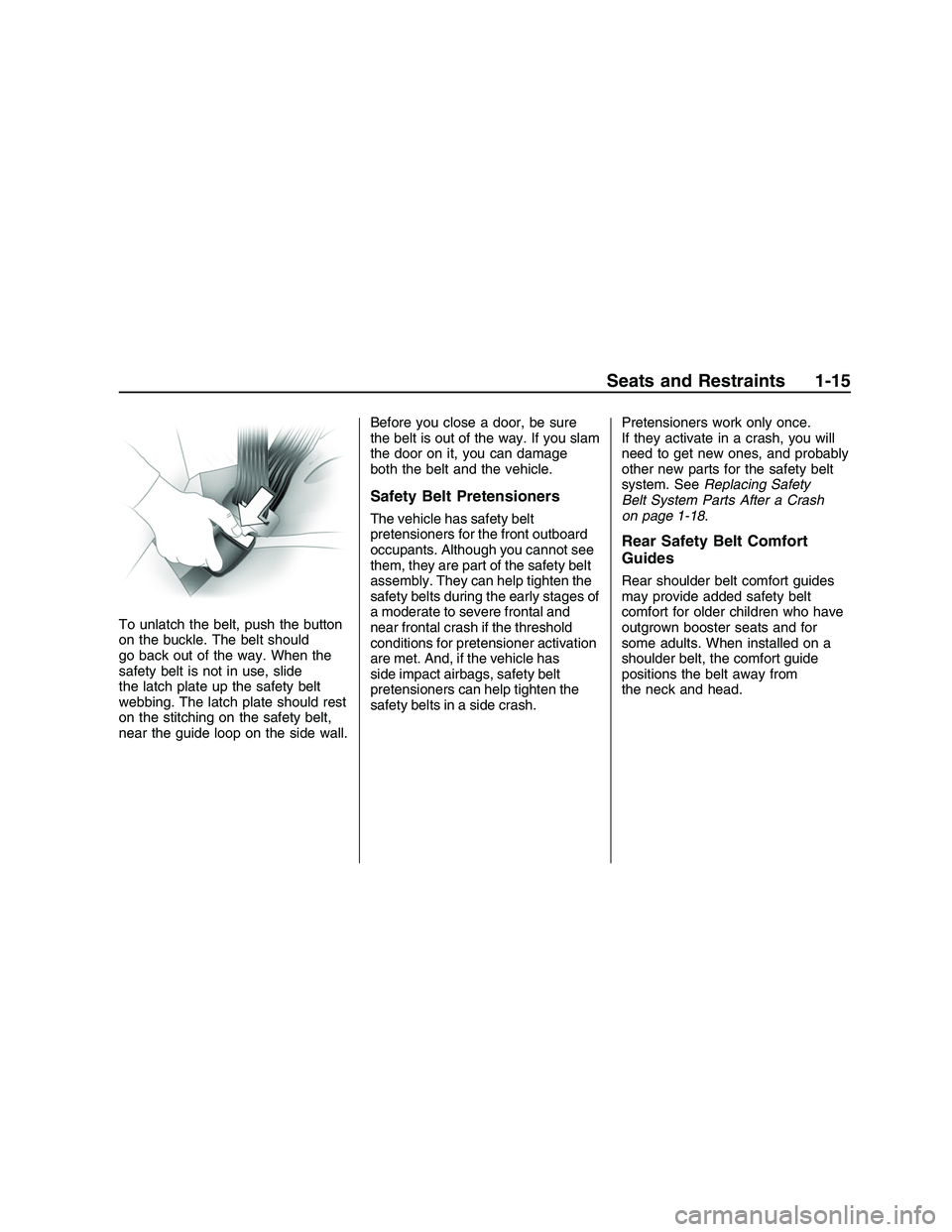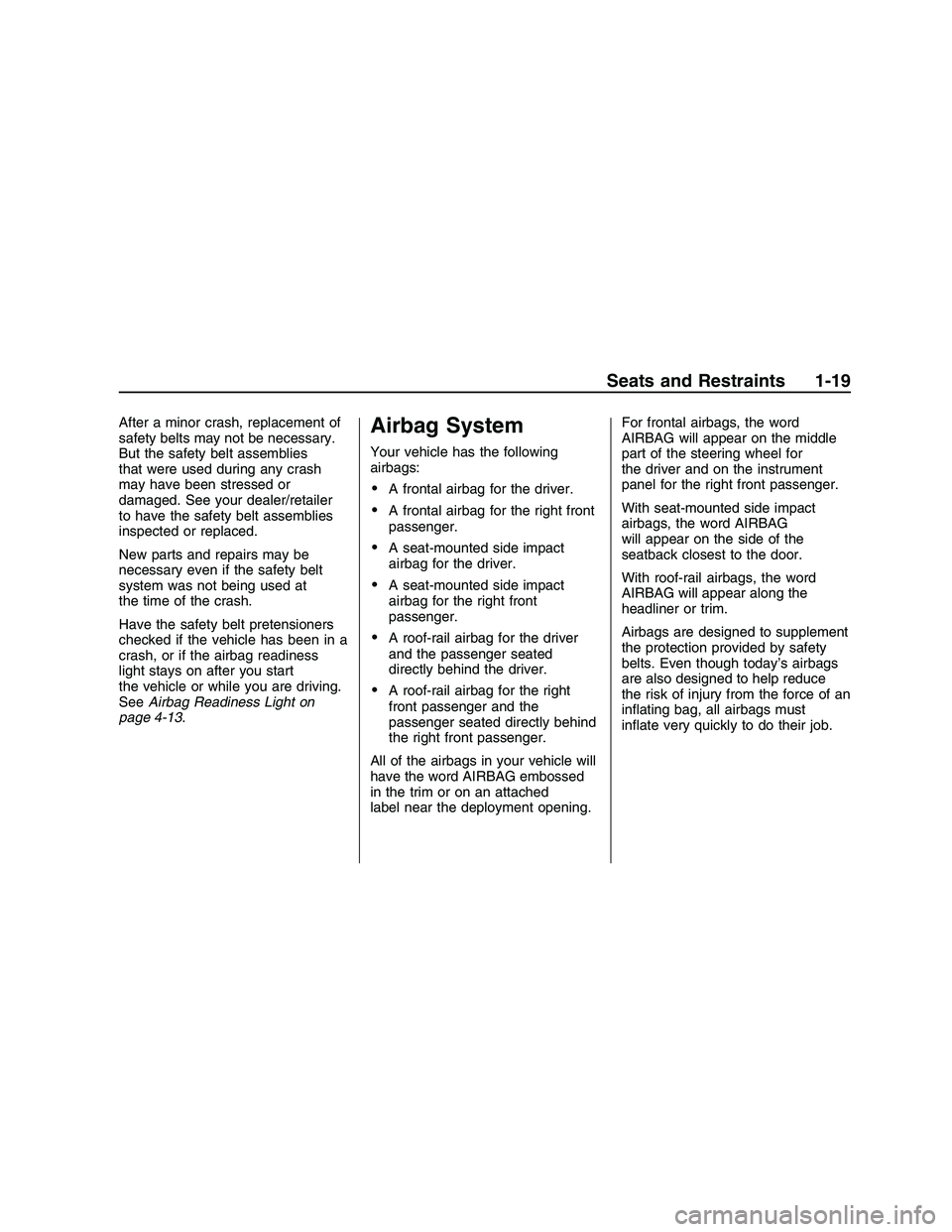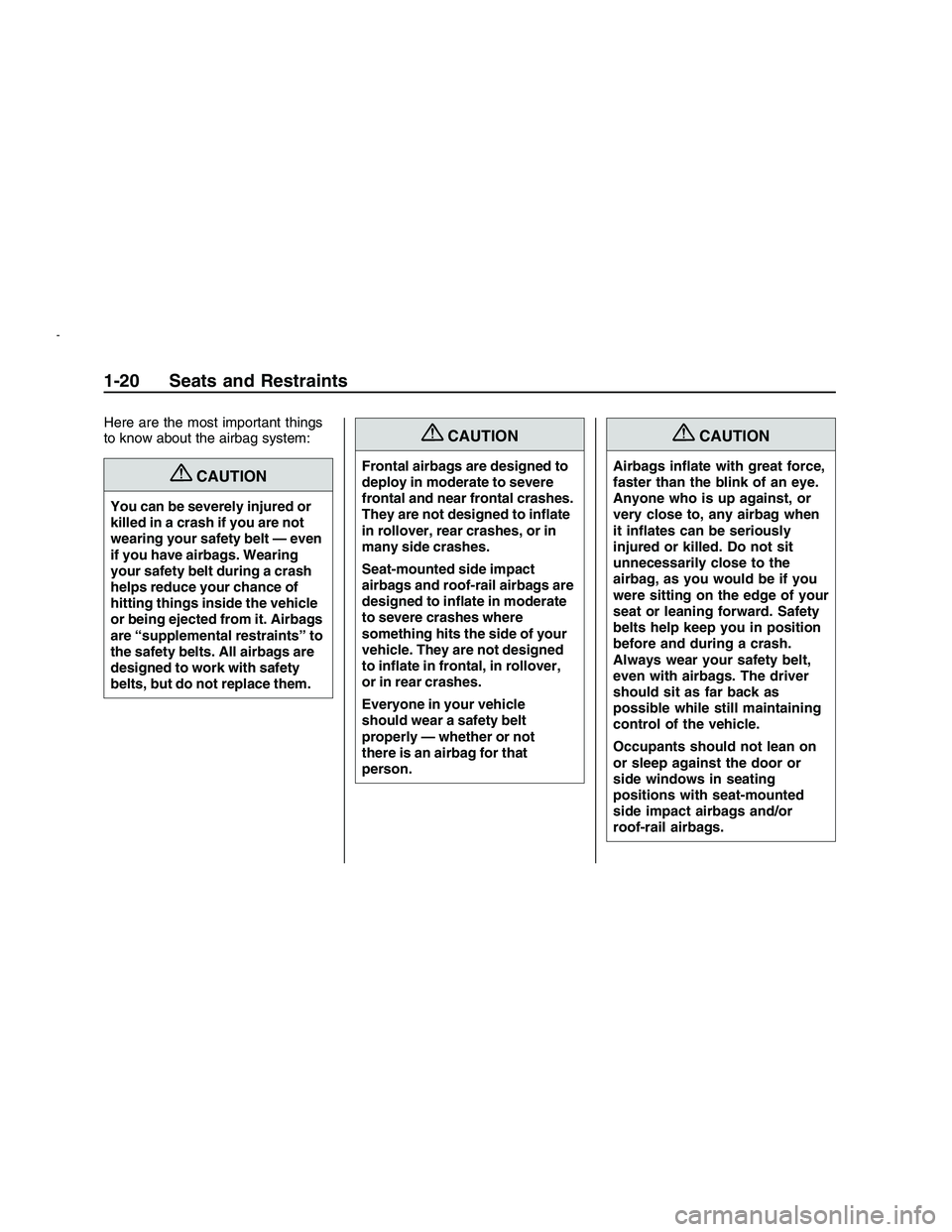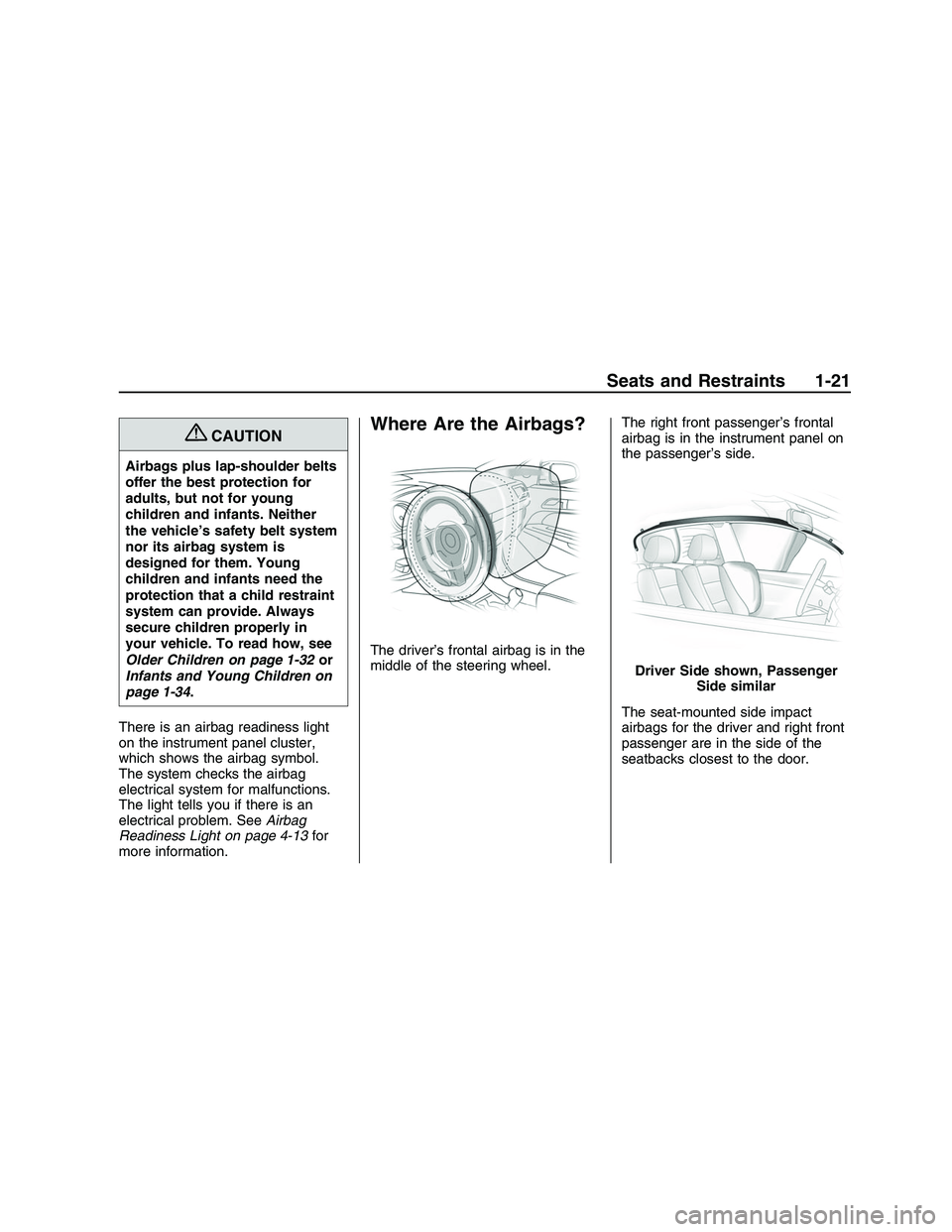2008 PONTIAC G8 airbag
[x] Cancel search: airbagPage 1 of 334

Seats and Restraints......... 1-1
Front Seats
.................... 1-2
Rear Seats
.................... 1-5
Safety Belts
................... 1-5
Airbag System
..............1-19
Child Restraints
.............1-32
Keys, Doors and
Windows............................ 2-1
Keys
............................. 2-2
Doors and Locks
............ 2-8
Theft-Deterrent
Systems
...................2-11
Windows
......................2-14
Mirrors
.........................2-16
Sunroof
........................2-18
Storage.............................. 3-1
Storage
......................... 3-1
Instruments and
Controls............................. 4-1
Instrument Panel
Overview
.................... 4-2
Warning Lights, Gages,
and Indicators
............4-10Driver Information
Center (DIC)
.............4-23
OnStar
®System
............4-36
Lighting............................. 5-1
Lighting
......................... 5-1
Infotainment...................... 6-1
Audio System(s)
............. 6-1
Climate Controls............... 7-1
Climate Controls
............. 7-1
Driving and Operating....... 8-1
Starting and Operating Your
Vehicle
....................... 8-2
Driving Your Vehicle
......8-13
Fuel
............................8-32
Vehicle Service
and Care............................ 9-1
Service
.......................... 9-2
Owner Checks
................ 9-5
Headlamp Aiming
..........9-27
Bulb Replacement
.........9-29Electrical System
...........9-32
Tires
...........................9-39
Tire Changing
...............9-62
Jump Starting
...............9-80
Towing
........................9-84
Appearance Care
..........9-91
Technical Data.................10-1
Vehicle Identi�cation
. . . . . . 10-1
Capacities and
Speci�cations
............10-2
Service and
Maintenance.....................11-1
Service and
Maintenance
..............11-1
Customer Information. . . . . . 12-1
Customer Information
. . . . . 12-1
Reporting Safety
Defects
...................12-14
Vehicle Data Recording
and Privacy
.............12-16
Index................................... i-1
2008 Pontiac G8 Owner ManualM
2008 - Pontiac G8 Owner Manual
Page 5 of 334

Seats and
Restraints
Front Seats
Front Seats........................1-2
Manual Seats.....................1-2
Power Seat(s).....................1-2
Lumbar Seat Adjustment. . . .1-2
Reclining Seatbacks...........1-3
Head Restraints..................1-4
Heated Seats.....................1-5
Rear Seats
Rear Seat Operation...........1-5
Safety Belts
Safety Belts........................1-5
How to Wear Safety Belts
Properly............................1-8
Lap-Shoulder Belt.............1-14
Safety Belt Use During
Pregnancy.......................1-17
Safety Belt Extender.........1-17
Safety Belt Check.............1-18
Care of Safety Belts.........1-18
Replacing Safety Belt
System Parts After
a Crash
...........................1-18
Airbag System
Airbag System..................1-19
Where Are the Airbags?. . .1-21
When Should an Airbag
In�ate?............................1-22
What Makes an Airbag
In�ate?............................1-24
How Does an Airbag
Restrain?........................1-24
What Will You See After
an Airbag In�ates?..........1-24
Passenger Sensing
System............................1-26
Servicing Your
Airbag-Equipped
Vehicle
............................1-30
Adding Equipment to
Your Airbag-Equipped
Vehicle
............................1-30
Airbag System Check.......1-31
Replacing Airbag System
Parts After a Crash.........1-32
Child Restraints
Older Children..................1-32
Infants and Young
Children..........................1-34
Child Restraint Systems. . . .1-37
Where to Put the
Restraint.........................1-38
Lower Anchors and
Tethers for Children
(LATCH)
..........................1-40
Replacing LATCH System
Parts After a Crash.........1-45
Securing Child Restraints
(Rear Seat).....................1-46
Securing Child Restraints
(Right Front Seat). . . . . . . . . . .1-48
Seats and Restraints 1-1
2008 - Pontiac G8 Owner Manual
Page 12 of 334

Questions and Answers About
Safety Belts
Q:
Will I be trapped in the vehicle
after a crash if I am wearing a
safety belt?
A:Youcouldbe — whether you are
wearing a safety belt or not. But
your chance of being conscious
during and after an accident, so
youcanunbuckle and get out, is
muchgreater if you are belted.
And you can unbuckle a safety
belt, even if you are upside down.
Q:If my vehicle has airbags,
why should I have to wear
safety belts?
A:Airbags are supplemental
systems only; so they workwith
safety belts — not instead of
them. Whether or not an airbag is
provided, all occupants still have
to buckle up to get the most
protection. That is true not only in
frontal collisions, but especially in
side and other collisions.
Q:If I am a good driver, and I
never drive far from home,
why should I wear safety
belts?
A:You may be an excellent driver,
but if you are in a crash — even
one that is not your fault — you
and your passenger(s) can be
hurt. Being a good driver does not
protect you from things beyond
your control, such as bad drivers.
Most accidents occur within
25 miles (40 km) of home. And
the greatest number of serious
injuries and deaths occur at
speeds of less than 40 mph
(65 km/h).
Safety belts are for everyone.
How to Wear Safety Belts
Properly
This section is only for people of
adult size.
Be aware that there are special
things to know about safety
belts and children. And there are
different rules for smaller children
and infants. If a child will be riding in
the vehicle, seeOlder Children on
page 1-32orInfants and Young
Children on page 1-34. Follow those
rules for everyone’s protection.
It is very important for all occupants
to buckle up. Statistics show that
unbelted people are hurt more often
in crashes than those who are
wearing safety belts.
Occupants who are not buckled up
can be thrown out of the vehicle
in a crash. And they can strike
others in the vehicle who are
wearing safety belts.
1-8 Seats and Restraints
2008 - Pontiac G8 Owner Manual
Page 19 of 334

To unlatch the belt, push the button
on the buckle. The belt should
go back out of the way. When the
safety belt is not in use, slide
the latch plate up the safety belt
webbing. The latch plate should rest
on the stitching on the safety belt,
near the guide loop on the side wall.Before you close a door, be sure
the belt is out of the way. If you slam
the door on it, you can damage
both the belt and the vehicle.
Safety Belt Pretensioners
The vehicle has safety belt
pretensioners for the front outboard
occupants. Although you cannot see
them, they are part of the safety belt
assembly. They can help tighten the
safety belts during the early stages of
a moderate to severe frontal and
near frontal crash if the threshold
conditions for pretensioner activation
are met. And, if the vehicle has
side impact airbags, safety belt
pretensioners can help tighten the
safety belts in a side crash.Pretensioners work only once.
If they activate in a crash, you will
need to get new ones, and probably
other new parts for the safety belt
system. SeeReplacing Safety
Belt System Parts After a Crash
on page 1-18.
Rear Safety Belt Comfort
Guides
Rear shoulder belt comfort guides
may provide added safety belt
comfort for older children who have
outgrown booster seats and for
some adults. When installed on a
shoulder belt, the comfort guide
positions the belt away from
the neck and head.
Seats and Restraints 1-15
2008 - Pontiac G8 Owner Manual
Page 23 of 334

After a minor crash, replacement of
safety belts may not be necessary.
But the safety belt assemblies
that were used during any crash
may have been stressed or
damaged. See your dealer/retailer
to have the safety belt assemblies
inspected or replaced.
New parts and repairs may be
necessary even if the safety belt
system was not being used at
the time of the crash.
Have the safety belt pretensioners
checked if the vehicle has been in a
crash, or if the airbag readiness
light stays on after you start
the vehicle or while you are driving.
SeeAirbag Readiness Light on
page 4-13.Airbag System
Your vehicle has the following
airbags:
A frontal airbag for the driver.
A frontal airbag for the right front
passenger.
A seat-mounted side impact
airbag for the driver.
A seat-mounted side impact
airbag for the right front
passenger.
A roof-rail airbag for the driver
and the passenger seated
directly behind the driver.
A roof-rail airbag for the right
front passenger and the
passenger seated directly behind
the right front passenger.
All of the airbags in your vehicle will
have the word AIRBAG embossed
in the trim or on an attached
label near the deployment opening.For frontal airbags, the word
AIRBAG will appear on the middle
part of the steering wheel for
the driver and on the instrument
panel for the right front passenger.
With seat-mounted side impact
airbags, the word AIRBAG
will appear on the side of the
seatback closest to the door.
With roof-rail airbags, the word
AIRBAG will appear along the
headliner or trim.
Airbags are designed to supplement
the protection provided by safety
belts. Even though today’s airbags
are also designed to help reduce
the risk of injury from the force of an
in�ating bag, all airbags must
in�ate very quickly to do their job.
Seats and Restraints 1-19
2008 - Pontiac G8 Owner Manual
Page 24 of 334

Here are the most important things
to know about the airbag system:
{CAUTION
You can be severely injured or
killed in a crash if you are not
wearing your safety belt — even
if you have airbags. Wearing
your safety belt during a crash
helps reduce your chance of
hitting things inside the vehicle
or being ejected from it. Airbags
are “supplemental restraints” to
the safety belts. All airbags are
designed to work with safety
belts, but do not replace them.
{CAUTION
Frontal airbags are designed to
deploy in moderate to severe
frontal and near frontal crashes.
They are not designed to in�ate
in rollover, rear crashes, or in
many side crashes.
Seat-mounted side impact
airbags and roof-rail airbags are
designed to in�ate in moderate
to severe crashes where
something hits the side of your
vehicle. They are not designed
to in�ate in frontal, in rollover,
or in rear crashes.
Everyone in your vehicle
should wear a safety belt
properly — whether or not
there is an airbag for that
person.
{CAUTION
Airbags in�ate with great force,
faster than the blink of an eye.
Anyone who is up against, or
very close to, any airbag when
it in�ates can be seriously
injured or killed. Do not sit
unnecessarily close to the
airbag, as you would be if you
were sitting on the edge of your
seat or leaning forward. Safety
belts help keep you in position
before and during a crash.
Always wear your safety belt,
even with airbags. The driver
should sit as far back as
possible while still maintaining
control of the vehicle.
Occupants should not lean on
or sleep against the door or
side windows in seating
positions with seat-mounted
side impact airbags and/or
roof-rail airbags.
1-20 Seats and Restraints
2008 - Pontiac G8 Owner Manual
Page 25 of 334

{CAUTION
Airbags plus lap-shoulder belts
offer the best protection for
adults, but not for young
children and infants. Neither
the vehicle’s safety belt system
nor its airbag system is
designed for them. Young
children and infants need the
protection that a child restraint
system can provide. Always
secure children properly in
your vehicle. To read how, see
Older Children on page 1-32or
Infants and Young Children on
page 1-34.
There is an airbag readiness light
on the instrument panel cluster,
which shows the airbag symbol.
The system checks the airbag
electrical system for malfunctions.
The light tells you if there is an
electrical problem. SeeAirbag
Readiness Light on page 4-13for
more information.
Where Are the Airbags?
The driver’s frontal airbag is in the
middle of the steering wheel.The right front passenger’s frontal
airbag is in the instrument panel on
the passenger’s side.
The seat-mounted side impact
airbags for the driver and right front
passenger are in the side of the
seatbacks closest to the door.
Driver Side shown, Passenger
Side similar
Seats and Restraints 1-21
2008 - Pontiac G8 Owner Manual
Page 26 of 334

The roof-rail airbags for the driver,
right front passenger, and second
row outboard passengers are in the
ceiling above the side windows.
{CAUTION
If something is between an
occupant and an airbag, the
airbag might not in�ate
properly or it might force the
object into that person causing
severe injury or even death.
The path of an in�ating airbag
must be kept clear. Do not put
anything between an occupant
and an airbag, and do not
attach or put anything on the
steering wheel hub or on or
near any other airbag covering.
(Continued)
CAUTION (Continued)
Do not use seat accessories
that block the in�ation path of a
seat-mounted side impact
airbag.
Never secure anything to the
roof of a vehicle with roof-rail
airbags by routing a rope or tie
down through any door or
window opening. If you do, the
path of an in�ating roof-rail
airbag will be blocked.
When Should an Airbag
In�ate?
Frontal airbags are designed to
in�ate in moderate to severe frontal
or near-frontal crashes to help
reduce the potential for severe
injuries mainly to the driver’s or right
front passenger’s head and chest.
However, they are only designed toin�ate if the impact exceeds a
predetermined deployment
threshold. Deployment thresholds
are used to predict how severe
a crash is likely to be in time for the
airbags to in�ate and help restrain
the occupants.
Whether the frontal airbags will or
should deploy is not based on
how fast your vehicle is traveling.
It depends largely on what you
hit, the direction of the impact, and
how quickly your vehicle slows
down.
Frontal airbags may in�ate at
different crash speeds. For example:
If the vehicle hits a stationary
object, the airbags could
in�ate at a different crash speed
than if the vehicle hits a
moving object.
If the vehicle hits an object that
deforms, the airbags could
in�ate at a different crash speed
than if the vehicle hits an
object that does not deform.
1-22 Seats and Restraints
2008 - Pontiac G8 Owner Manual